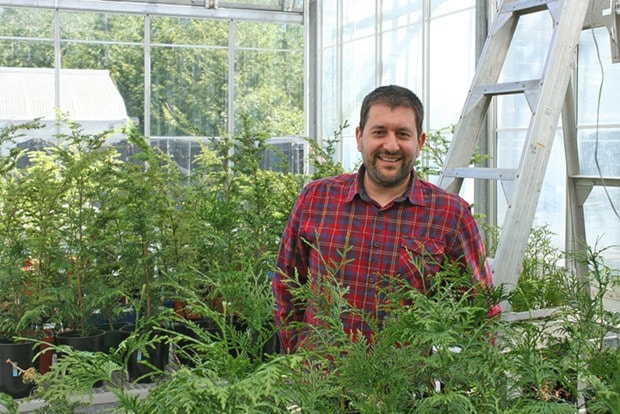In a greenhouse behind the Pacific Forestry Centre, research scientist Cosmin Fillipescu points to a tiny wrapping foil around the base of an evergreen seedling.
Within the foil is a fungus. Researchers are trying to recreate the butt rot found in millions of B.C.’s most treasured tree, the western red cedar.
There are few woods, if any, that are as durable and in demand as the western red cedar. First Nations call it the ‘tree of life,’ for the tree’s variability.
To date, red cedar is not under threat. But with climate change, and an increasing global demand, it will be, and in more ways than one. That’s why Fillipescu spends his days at the Pacific Forestry Centre in Saanich dedicated to understanding what’s in store for B.C.’s red cedar stock.
“Red cedar is responsible for 1,900 jobs in B.C.,” Fillipescu said. “It’s a $1.3 billion annual industry.”
The Royal Oak resident focuses on forest ecophysiology with the Canadian Wood Fibre Centre of Natural Resources Canada, and leads the Cedar Research Working Group.
It’s a multi-year research project with other research scientists, graduate students, First Nations, provincial and federal representatives, to look at the western red cedar from a range of viewpoints such as economics, ecology, disease, quality and value of forest products and of course, climate change.
“The goal is to learn how to manage western red cedar as a long-term, sustainable, high-quality resource for the future,” Fillipescu said.
Butt rot, for example, has been an issue with red cedar since the beginning of the logging industry. But in the past, the industry could continue logging red cedar until the amount of rotten trees were compensated for.
But now logging is done at a sustainable rate, and there is a demand to increase the amount of usable yield.
There is about 750 million cubic metres of western red cedar in B.C. About one-third of that is on forested managed areas, 500 million of it is protected, and the industry logs about four million cubic metres per year on average. In turn, nine million seedlings are planted per year.
“We have a research project going to see if the amount of rotten trees can be minimized (the trees look healthy until they’ve been felled) through selective breeding,” Fillipescu said.
Selective breeding has been done. In one case, researchers have tried to find a strain of western red cedar that is less appealing to deer. Ungulates become part of the problem when replanting red cedar, as they enjoy the tree in its seedling stage.
“We have to find a way to breed for both deer browsing,” Fillipescu said, “and to see if we can find a species that is resistant to the rot.”
Red cedar leaf blight is another problem that could grow as the climate becomes warmer and drier along B.C.’s coast, which is where 80 per cent of the province’s western red cedar is found. Already, the amount of yellow cedar is in decline due to dwindling snowpack, which exposes the roots, and other causes.
“Another thing we want to know, is if we can get lower rotations of crops,” Fillipescu asks. “Right now it’s 60 to 80 years.”
The working group is also focusing on whether second growth trees are providing the same quality of wood and disease resistance as their forebears, what environmental conditions red cedar will need to adapt to, and how to manage regeneration of red cedar and its demand in overseas markets for Canadian forest products.
Visit cedargroup.blogspot.ca/ for more information.
